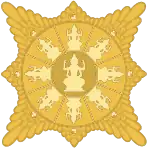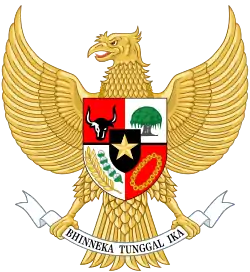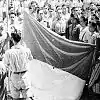Operation Kraai
Operation Kraai (Operation Crow) was a Dutch military offensive against the newly formed Republic of Indonesia in December 1948. With the advantage of surprise the Dutch managed to capture the Indonesian Republic's temporary capital, Yogyakarta, and seized Indonesian leaders such as Republican President Sukarno. This apparent military success was however followed by guerrilla warfare, while the violation of the Renville Agreement ceasefire diplomatically isolated the Dutch, leading to the Dutch–Indonesian Round Table Conference and recognition of the Indonesian National Revolution.[3]
| Operation Kraai | |||||||
|---|---|---|---|---|---|---|---|
| Part of the Indonesian National Revolution | |||||||
| |||||||
| Belligerents | |||||||
|
|
| ||||||
| Commanders and leaders | |||||||
| Units involved | |||||||
| Strength | |||||||
|
| ||||||
| Casualties and losses | |||||||
| 62,000 | 3,000 | ||||||
Referred to by the Dutch as the second Politionele acties. It is more commonly known in Indonesian history books and military records as Agresi Militer Belanda II (Dutch Military Aggression II).[4]
Background
Part of a series on the |
|---|
| History of Indonesia |
   |
| Timeline |
|
|
The second Politionele actie was aimed at forcing the republic to co-operate with the Dutch government in the implementation of the federalist policy as stipulated in the Linggadjati Agreement. The purpose was to organise the new Indonesia as a federal state that would remain closely associated with the Netherlands.[5] The Indonesians had breached the armistice signed following Operation Product. That armistice, the Renville Agreement, stipulated the withdrawal of Indonesian forces from Dutch-occupied territory in exchange for ending the Dutch naval blockade. The Indonesian military originally complied with the agreement, but secretly returned some time later and began guerrilla operations against the Dutch.[6]
By September 1948, the Dutch military command had succeeded in decoding the republic's encrypted secret code, gaining crucial intelligence on Indonesian military and diplomatic strategies and plans. This allowed General Simon Hendrik Spoor to counteract republic actions on the battlefield and diplomatic stage. The Dutch were so confident of this advantage that they held a press conference in Jakarta three days prior to the actual attack.[7] The Dutch also timed their attack to co-ordinate with plans by the Indian Prime Minister Jawaharlal Nehru to dispatch a private plane to fly Sukarno and Mohammad Hatta to Bukittinggi in West Sumatra where they would head an emergency government. A republican delegation led by Sukarno would then be flown to New York via New Delhi to advocate the republic's cause in the United Nations General Assembly. Throughout the Indonesian National Revolution, newly independent India had been sympathetic to the republic's cause, which they viewed as a struggle against Western imperialism.[7]
On 18 December, radio broadcasts in Jakarta reported that the Dutch High Commissioner, Louis Beel, was going to give an important speech the next day. This news did not reach Yogyakarta because the Dutch had cut the communication line. Meanwhile, Spoor gave an instruction to begin a full-scale surprise attack against the Republic. He timed the attack prior to coincide with Tentara Nasional Indonesia military exercises on 19 December, giving Dutch movements some temporary camouflage and enabling them to take the enemy by surprise. The attack was also launched without the prior knowledge of the UN Committee of Good Offices.[1]
Battle
First offensive
The first offensive began in the early hours of 19 December. At 04:30, Dutch aircraft took off from Bandung; heading for Yogyakarta via the Indian Ocean. Meanwhile, the Dutch High Commissioner Beel announced that the Dutch were no longer bound by the Renville Agreement on radio. The operation began as the Dutch attacked major Indonesian centres in Java and Sumatra.[1] At 05:30, Maguwo airport and the radio station at military aircraft including Yogyakarta was bombed by the Royal Netherlands East Indies Air Force.[1] The republic fielded only three captured Japanese Mitsubishi Zeros[1] whereas the ML-KNIL had several American-built P-40 Kittyhawk and P-51 Mustang fighters, B-25 Mitchell bombers and 23 Douglas DC-3s carrying approximately 900 troops.[2]
Dutch paratroopers landed at Maguwo airport, which was defended by 47 lightly armed Indonesian Air Force cadets who lacked anti-aircraft machine guns. In advance, dummies were landed by the Dutch to draw enemy fire which enabled Dutch fighter planes to strafe the defenders.[1] The skirmish lasted for 25 minutes ending with the Dutch taking over Maguwo; killing 128 republicans with no casualties.[8] Having secured the airport perimeter by 06:45, the Dutch were able to land airborne troops in two successive waves and use Maguwo as an airhead for reinforcements from their main base in Semarang.[1] At 8:30 am, General Spoor gave a radio broadcast ordering his forces to cross the Van Mook line and capture Yogyakarta to "purge" the republic of "unreliable elements".[1]
The main aim of Operation Kraai was to quickly destroy the Tentara Nasional Indonesia (TNI) which Spoor thought would desperately defend their capital. Thus, with Dutch superiority both in the air and on land, the Dutch army would easily execute a final and decisive victory upon the Indonesian army. However, most of the TNI had left Yogyakarta, defending western Yogyakarta's border from another Dutch military campaign. The commander General Nasution himself was on an inspection tour in East Java.[1] The air attack found the Indonesians unprepared and within hours, the advancing Dutch army had quickly taken the airport, main road, bridge and strategic locations.[1] General Sudirman's strategy was to avoid any major contact with the Dutch main army, thus saving the Indonesians from total defeat. He would prefer to lose territory but gain extra time to consolidate his army.[8]
Capture of Yogyakarta
After hearing of the surprise attack, Indonesian military commander General Sudirman broadcast Perintah kilat (quick command) via radios. He also requested Sukarno and other leaders to evacuate and join his guerrilla army. After a cabinet meeting, they refused and decided to stay in Yogyakarta, and keep communicating with United Nations and Komisi Tiga Negara envoys. Sukarno also announced a plan for "emergency government" in Sumatra, in the event something happened to the Indonesian leadership in Yogyakarta.[9]
Meanwhile, 2,600 fully armed Dutch troops (infantry and paratroopers) led by Colonel Dirk Reinhard Adelbert van Langen had gathered in Maguwo, ready to capture Yogyakarta. On that same day most of Yogyakarta fell into Dutch hands, with key targets like the air force and chief-of-staff headquarters razed by both Indonesian "scorched earth" tactics and Dutch bombing.[10] Indonesian President Sukarno, Vice-President Mohammad Hatta, and ex prime minister Sutan Sjahrir were seized by the Dutch and subsequently exiled to Bangka.[11] They let themselves be captured hoping it would outrage international support. However, this action was later criticised among Indonesian military circles which regarded it as an act of cowardice by the political leadership.[11] Sultan Hamengkubuwono IX stayed at his palace in Yogyakarta and did not leave during the entire occupation. The Sultan himself refused to co-operate with the Dutch administration and rejected mediation attempts by the pro-Dutch Sultan of Pontianak Hamid II.[12]
By 20 December, all remaining republican troops in Yogya had been withdrawn. All parts of Indonesia except Aceh and some cantons in Sumatra fell under Dutch control. Sudirman, who was suffering from tuberculosis, led the guerrillas from his sickbed. General Abdul Haris Nasution, military commander of Java territories, declared military government in Java and initiated a new guerrilla tactic called Pertahanan Keamanan Rakyat Semesta (Nation in Arms), transforming the Javan countryside into a guerrilla front with civilian support.[13]
A previously-planned emergency government was declared on 19 December, the Emergency Government of the Republic of Indonesia, based on Bukittinggi, West Sumatra, led by Sjafruddin Prawiranegara. Sudirman radioed his immediate support for this government.
Aftermath
This attack was well publicised internationally with many newspapers, including those in the United States, condemning Dutch attacks in their editorials. The United States threatened to suspend Marshall Plan aid to the Dutch. This included funds vital for Dutch post-World War II rebuilding that had so far totalled $US 1 billion.[14] The Netherlands government had spent an amount equivalent to almost half of this funding their campaigns in Indonesia. The perception that American aid was being used to fund "a senile and ineffectual imperialism" encouraged many key voices in the United States – including those amongst the US Republican Party – and from within American churches and NGOs to speak out in support of Indonesian independence.[15]
On 24 December, the UN Security Council called for the end of hostilities. In January 1949, it passed a resolution demanding the reinstatement of the republican government.[16] The Dutch had achieved most of their objectives and announced a ceasefire in Java on 31 December and on 5 January in Sumatra.[17] The guerrilla war nonetheless continued. Hostilities eventually ended on 7 May with the signing of the Roem–Van Roijen Agreement.
References
Footnotes
- Kahin (2003), p. 89
- Kahin (2003), p. 90
- Ricklefs (1993), p.230 "... both a military and a political catastrophe for [the Dutch]".
- Zweers (1995)
- Ricklefs (1993), p.223
- Kahin (2003), p. 19
- Kahin (2003), p. 87
- Operation Kraai (General Spoor) vs Surat Perintah no. 1 (General Sudirman)
- Bertrand (2004), p. 166
- Kahin (2003), p. 91
- Kahin (2003), p. 94
- Kahin (2003), p. 106
- Vickers (2005), p. 111
- Friend (2003), page 37
- Friend (2003), page 38
- "The National Revolution, 1945–50". Country Studies, Indonesia. U.S. Library of Congress.
- Ricklefs (1993), p.231
Bibliography
| Wikimedia Commons has media related to Second Politionele Actie. |
- Bertrand, Jacques (2004). Nationalism and Ethnic Conflict in Indonesia. Cambridge University Press. p. 166. ISBN 0-521-52441-5.
- Darusman, Suryono (1992). Singapore and the Indonesian Revolution, 1945–50. Singapore: Institute of Southeast Asian Studies. ISBN 981-3016-17-5.
- Jason, Robert (2008). Modern Military Aircraft in Combat First Edition. London: Amber Books.
- Kahin, George McTurnan; Audrey Kahin (2003). Southeast Asia: A Testament. London: Routledge Curzon. ISBN 0-415-29975-6.
- Ricklefs, M.C. (1993). A History of Modern Indonesia Since c. 1300. San Francisco: Stanford University Press.
- Zweers, L. (1995). Agressi II: Operatie Kraai. De vergeten beelden van de tweede politionele actie. The Hague: SDU Uitgevers. Archived from the original on 8 February 2012.
- Operation Kraai (General Spoor) vs Surat Perintah no. 1 (General Sudirman), Gramedia Publisher-Indonesian Language
